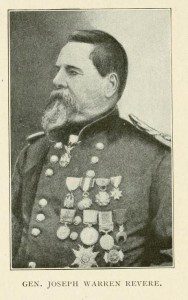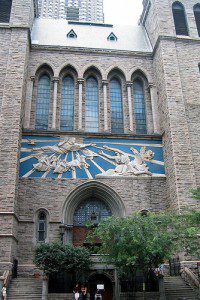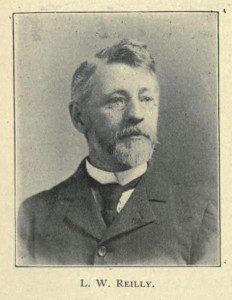FATHER DESHON AT REST.
Last Rites Over Remains of Paulist Founder.
Archbishops Farley and Ryan and Many Priests
Participate.
Body in State Viewed by 20,000.
The New York Times, January 3, 1904
The body of Father George Deshon, the last of the five founders of the Paulist Order, and for the last six years its Superior General, was laid to rest yesterday in the crypt which he himself had designed, under the south tower of the Church of St. Paul the Apostle, at Columbus Avenue and Fifty-ninth Street. Impressive ceremonies that marked the burial service there were participated in by Archbishop Farley of
this diocese, Archbishop Ryan of Philadelphia, Bishop Hendrick of Manila, and Msgrs. Mooney and Edwards of this city and a very large number of priests.
When placed in the tomb the body of the priest was robed in the habit of the Paulist order, over which were the white and gold vestments of the Mass. Among the flowers in the casket were a wreath of immortelles sent by the cadets of West Point, of which Father Deshon was a
graduate, and a floral column sent by the Rev. W.M. Grosvenor, rector of the Protestant Episcopal Church of the Incarnation, and an old friend of the dead priest.
The solemn high requiem mass which preceded the ceremony of depositing the body in the crypt was celebrated by the Rev. Father George Searle, Vice Superior General of the Paulists. The Rev. Father John Hughes was Deacon, the Rev. Father Timothy Menton Sub-Deacon, and the Rev. Father Thomas McNichol master of ceremonies. The Rev. Father Michael J. Lavelle, rector of St. Patrick’s Cathedral, eulogized the dead priest, and Archbishop Farley pronounced the final absolution. Father Lavelle said in part:
The last of the five founders of the Paulists lies cold in death to-day, and our
hearts are broken with grief over his loss to us. With the departure of Father
Deshon we have lost a treasure which it is impossible for us not to feel the
lack of. A great leader, a strong and bountiful father has been taken from us,
and it would be impossible for us not to yield to the grief which is in our
hearts and causes us to shed tears.Notwithstanding his advanced age, Father Deshon, until a few weeks ago, seemed to be in the
full vigor of life. His brain was clear, he was resourceful, and his heart was
one of the kindliest. But in our despair we have knowledge of how grandly and
successfully he did his duty. His spotless character and record will live
forever.George Deshon was born Jan. 30, 1823, at New London, Conn. He came of old Huguenot stock and was sturdy and hard-headed but honest. This was the last sort of stock to expect a large and powerful priest of the Roman Catholic Church to spring from, but the Creator is all wise and chooses his own methods and tools. All his early life and youthful training were on lines as far as possible from the Roman Catholic Church and from the priesthood. He was brave and daring, and loved to read tales of the conquerors of the olden times. He secured a nomination to the Military School at West Point, and while there he was the classmate, roommate, and chum of Gen. Grant. Had George Deshon remained in the profession of arms he might have become the great General to end the fratricidal struggle.
Shortly after graduating in the class of which he was second and Grant twenty-third, Deshon, because of his great learning, was made a Professor at the Military Academy. This was a high honor to a young man. He began studying the history of the great division which separated professing Christians to the Church of Christ. Then it was that he sacrificed everything to follow Christ, and in 1851 he was baptized into the Roman Catholic Church. But he was a soldier, and having resigned from the army of his country, the army he loved so well, he must be a soldier still. Therefore, after due consideration and preparation, he presented himself as a candidate for the priesthood. In 1855 he was ordained a member of the Order of the Most Holy Redeemer.
It is not necessary for me to rehearse the story of the separation of the five great Paulists from the Redemptorist Order, or to tell you about the establishment of the Paulist community.
Under his direction the work of the Paulists had expanded, and to-day they have three houses, 300 priests, and a large number of scholastics. The community is still destined in the near future to exert a still larger influence for the Church in this country.
As Father Deshon grew older his intellect became brighter and his influence greater. He may be said to have died with the harness on. He was part and parcel of all the work of the Paulist community since its foundation. That work began at home and at the time of the building of this church it was surrounded by green fields. Now it is in the centre of a densely settled part of the city, and its congregation is perhaps one of the largest. And during this period of fifty years Father Deshon labored first for the benefit of the people. The Paulists worked in season and out of season with magnificent zeal. Hundreds of thousands were instructed in private before missions for non-Catholics were opened, and later the Apostolic Mission House at Washington was opened.
Somebody speaking of the first Paulists characterized Hecker as the idealist of the company. Walworth the orator, Hewitt the scholar. Baker the essence, and Deshon the practical man. He was the compass which directed the vessel to a safe and suitable anchorage, and to him must be credited the building of this grand church and the spread of the order.
The remains were carried to the crypt by six members of the Paulist order. While the body lay in state in the church, whither it was carried on Friday night, more than 20,000 persons viewed it.
NOTE
Founded in 1858, the Missionary Society of St. Paul the Apostle, better known as the Paulist Fathers, were founded by Servant of
God Isaac Thomas Hecker to work for the conversion of America to Catholicism. In addition to Hecker, its founding members were Fathers George Deshon, Francis Baker, Augustine Hewitt, and Clarence Walworth. Today they still work in the field of evangelization, as well as
communications. They also work to reconcile fallen- away Catholics with the Church.
Of the West Point Class of 1843, 16 of the 39 graduates became generals in the Union and Confederate Armies.

![Deshon[1]](https://wp-media.patheos.com/blogs/sites/224/2012/06/Deshon1-215x300.jpg)










